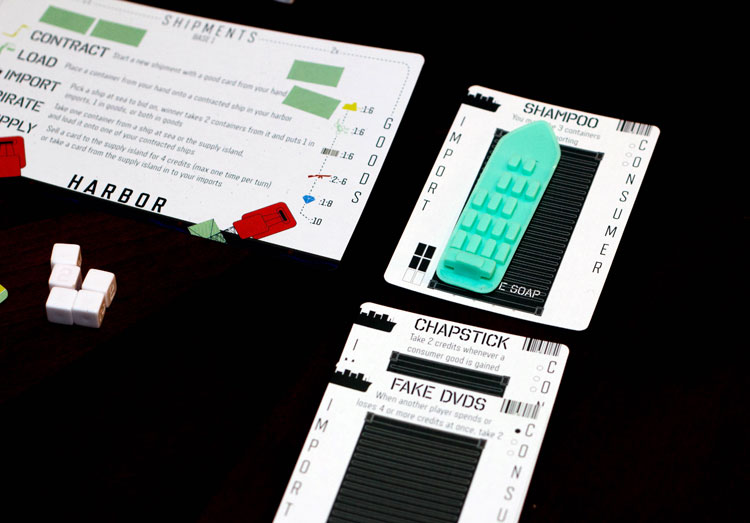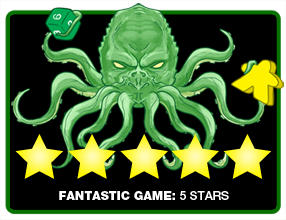 I know what you are thinking. Nothing sounds more exciting than jumping into the business of importing and exporting. What could be more exciting than loading some containers onto a boat and shipping them out across the vast ocean?
I know what you are thinking. Nothing sounds more exciting than jumping into the business of importing and exporting. What could be more exciting than loading some containers onto a boat and shipping them out across the vast ocean?
Import / Export allows you to tackle those logistics using mechanisms that will be familiar to anyone who has played Glory to Rome. Chances are decent you haven’t played Glory to Rome, since it’s nearly impossible to find, but you should read on either way. Import / Export adds a bit of an economic component to the GTR formula. So let’s see how it works!
Import / Export plays 2-6 players in about an hour. It tends to run longer at higher player counts and is best with 2-4.
Gameplay Overview:
Throughout a game of Import / Export you will be attempting to secure contracts for your ships and load them with goods. Once out to sea, you will need to have those containers imported to clear your ship’s cargo so they can return to the harbor and do it all over again.
Gameplay in Import / Export focuses on its multi-use cards. Most importantly, each card can be used to start one of the main actions:
- Contract – Allows you to place a card on a ship in the harbor as a contract. Once completed, that contract will give you a special power or ability.
- Load – When you play a load card you can place a card from your hand onto a contracted ship.
- Import – Choose a ship and have players bid on the right to bring goods from that ship into their harbor.
- Pirate – Take a card from a ship at sea or on the neutral “supply island” and place it on a contracted ship.
- Supply – Add a card to supply island for 4 credits or take a card from supply island into your imports.

In addition to starting a main action, each card potentially is a contract, a container to load, and a future good or import for your harbor.
On your turn you won’t be the only one paying attention though. Every player may follow whatever main action you initiate by playing that type of action card from their hand (or two of the same color can substitute). Players who choose not to follow your action draw cards instead.
The import action specifically is different as it triggers an auction between the leading player and whoever chooses to follow. The leader chooses a ship and a closed-bid auction occurs with players bidding the number of credits they wish to pay. Whoever pays the most can take two containers from the chosen ship into their harbor.
At least one of the imported cards must go into the “goods” section of the harbor which provides the ability to take higher level contracts and end game points. One of the containers can also be placed in “imports.” Imports allow a player to take an action multiple times or follow another player’s action without playing a card from their hand. For instance, if you have two load imports, you can load three containers from your hand when you lead a load action.
Every time a ship’s contract is filled and is sent out to sea, the player receives credits based on the number of containers required by the contracts. The game ends when one player amasses 50 or more credits or all of the cards are in play. Additional points are added in for the goods imported into each player’s harbor and the player with the most points is the winner.

Game Experience:
The idea—fill your ships up with goods and then import those goods back in—is simple enough. The faster you can empty your boats at sea, the faster they will float back into your harbor and allow you to keep cycling them through the process. Small contracts, however, pay a small amount of credits and don’t necessarily give you powerful abilities. If you are able to complete contracts that require more containers or higher levels of technology you will not only earn more credits, but also unlock game-changing abilities.

The real draw for Import / Export comes from the ability to build your own engine. You are limited to one import in your harbor at the beginning of the game, but as you complete additional shipments this limit increases. The technology tree that develops as you gain more unique abilities from shipments and increase the number of imports you have allows you to build a different engine each and every game.
Depending on those shipments and imports, you have lots of different options for how to score points as well. You can focus on importing goods, as they all score points, and you can earn points for having majorities as well. Alternatively you can focus on completing huge contracts that can score you a large amount of points and great abilities. The Platinum Rings contract, for instance, allows you to draw 8 cards and play them immediately when you successfully complete the shipment.
Import / Export owes a great deal of inspiration to Glory to Rome. It also features multi-use cards and the ability for other players to follow actions. But the auction mechanism in Import / Export really sets the game apart. You have to bid credits to win the auction, essentially victory points. Often this is a wise investment in your future—winning bidders will get goods which also translate to VPs and better contracts, and imports which power up future actions. Other players will undoubtedly try to make it expensive for you and you have to be careful to not overpay, especially as the game starts to come to a close.

Surprisingly, given how integral the auctions are, I really enjoy Import / Export at 2 players. Auctions don’t often work well with 2 and it certainly plays out a bit differently in this game. Just participating in the auction—which only costs you a card—is enough to make your opponent give up some of his credits just to insure he is able to win the bid. The game begins to slow down with 5 and 6 players, so I prefer to keep it to 4 or less when possible.
There is a bit of a learning curve to Import / Export. Multi-use cards in general can be hard to wrap your head around as each card can do almost anything. Remembering what each action does is also burdensome at times. Pirate and Import both take containers out of the sea, for instance. But Pirate loads them onto contracted ships and Import puts them in your harbor. Some of the wording on cards can be unclear and send you digging for the rulebook. It isn’t particular difficult, but it can be a lot to keep straight in the first game or two.

Final Thoughts:
Although players start with mostly symmetric options, by the end of the game each player is doing wildly different things. Each game of Import / Export feels a little different. Even though it is a card game where you are limited by what you draw, you have the ability to cycle through your hand very quickly and there is rarely a time when the cards truly work against you.
Import / Export hits on everything it is trying to do. It plays quickly but with plenty of time for players to feel like they can make long-term plans and see them out. As heavier games tend to be my preference; I’m often skeptical of 60 minute games that claim to pack in a lot of interesting decisions. Import / Export does exactly that; it is a great game that my group will continue to revisit often.
Final Score: 5 Stars – A great game with lots of players interaction without feeling mean. Depth of strategy and hundreds of unique powers you can gain give Import / Export near infinite replay value.
 Hits:
Hits:
• Huge number of unique powers available that lead to different strategies
• Each card has many uses
• Auction mechanism adds a neat player interaction element without taking the focus
Misses:
• Learning curve is a little higher than average
• Wording on some cards could be clearer





















